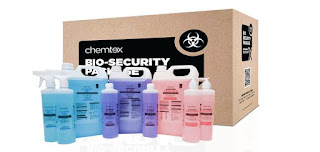Replacing Sodium Hypochlorite with Double Chain QAC based
Disinfectant
Remember
that pungent smell when mass disinfection of public places occurs. That same
irritating smell you can relate to in swimming pools, and your eyes itch and
redden, and your skin itches, and there is a big board saying “Chlorine in
pool”, that’s hypochlorous acid, viz., when sodium hypochlorite breaks down.
Sodium
hypochlorite/ Hypo (NaOCl) is inorganic chlorine based liquid disinfectant,
available as aqueous solutions of 5.25% - 6.15% (household bleach) or
concentrated 12% NaOCl solutions.
Large
quantities are also used as a disinfectant in water and wastewater treatment
and sanitary equipment. In food processing, sodium hypochlorite is used to
sanitize food preparation equipment, in fruit and vegetable processing,
mushroom production, hog, beef and poultry production, and fish processing.
Typical
Uses of Hypo:
·
2%: Shock Chlorination
of Wells
· 3 – 6%: Household
Disinfectant, Laundering Clothes, Dentistry Root Canal Treatment, Dairy
Industry, Disinfectant in Hospitals, Food Processing, Mushroom Production, Hog,
Beef, and Poultry Productions, Maple Syrup Production, Fish Processing, etc.
·
12 – 16%: Disinfectant
in Swimming Pools, Water Treatment, Waste Water Treatment, Pavement Spraying,
Mass Disinfection.
So,
where does Sodium Hypochlorite go wrong?
There
are five types of Chlorine available in the market; Sodium hypochlorite,
Lithium hypochlorite, Calcium hypochlorite, Dichlor, and Trichlor. The first
three are unstable, unlike the stable last two.
Sodium hypochlorite with water breaks into hypochlorite ions that increase the overall pH of the system; we know pathogens that can survive alkaline atmosphere. Also, the high pH of hypochlorite will attack metals and generates hydrogen gas when in contact with aluminum, it even eats through connecting glue (fumed silica), threaded fittings, etc.
Decomposition occurs faster at higher temperatures and
concentrations and with metal contamination. General fiberglass tanks are used,
at cooler temperatures to prevent hazards of hypo. If hypochlorite is exposed
to acid or ammonia, chlorine gas will be released.
If
the water hardness is exceedingly high, the high pH hypochlorite precipitates
the calcium and magnesium, leading to scaling problem.
Mixing
anything with hypochlorite can be extremely dangerous. Contact between
hypochlorite and other chemicals such as alum, ferric, or sodium bisulphate,
can cause an uncontrolled explosive release of energy, heat, and chlorine gas.
Hypo
efficacy becomes limited when it comes in contact with more than 80% organic
matter, neutralizing its oxidation effects. Hypo breaks down under sunlight,
taking away the residual activity and the contact period.
Human
Contact Hazards:
·
Sodium Hypochlorite
and ammonia mix, forms a dangerous gas potentially leading to choking and
breathing difficulty.
·
Avoid swallowing and
getting sodium hypochlorite in the eyes or on the skin. Produces eye
irritation, skin irritation and whitening, inhalation of fumes produce throat,
esophageal, and gastric burns.
·
Mutagenic and toxic
when it comes in contact with ammonium salts, listed under Class 8 Corrosive
Substances. Chronic (long-term) exposure to chlorine gas in workers has
resulted in respiratory effects, including eye and throat irritation and
airflow obstruction.
·
Residual chlorine
molecules react with this harmless organic material to form a group of
chlorinated chemical compounds, THMs (Trihalomethanes): Dibromochloromethane
(CHClBr2),
Bromoform (CHBr3), Chloroform (CHCl3), and Dichlorobromomethane (CHCl2Br). They are
tasteless and odourless, but harmful and potentially toxic.
Alstasan
II 256: Our Safe Alternative
Alstasan
II 256 is specifically formulated with double chain Quaternary Compounds which
on application completely eradicates pathogens, inclusive of sporicidal
bacteria and enveloped viruses such the coronavirus.
QACs
are surface active agents which interlinks with the cell membrane of pathogens,
altering its structure and its water-repelling attribute, because of which it
is considered super effectual against lipid-enveloped viruses. The R group
present in Quaternary Ammonium Compound’s structure with long double alkyl
chains enables prompt neutralization of organic matter’s synthesis in the
microbial cell, denaturing their essential cellular enzymes and proteins, and
distorting it completely.
Application Areas: Spraying in Infected/ critical areas, high traffic public areas such as metro stations, movie theatres, malls, showrooms, offices, F&B preparation areas, pavements, floors, railway platforms, dip tray for shoes, air fumigating of closed indoor spaces.
Key
Features:
·
Highly effective
virudical chemical with de-odourizer
·
Non-tainting nature,
safe for use on most MoC (Materials of Construction)
·
Easy to dose and
apply; dilute at recommended concentration and mopped
·
Leaves a refreshing
fragrance post usage
·
Multiple applications
of spraying, mopping, fumigation
Dominance
of Alstasan II 256 over Sodium Hypochlorite:
Double
chain QAC blends are highly effective especially over vegetative bacteria and
enveloped viruses like SARS-CoV-2, inhibiting their spread and replication
within seconds of application at lower use concentration (USEPA approved
formulation)
· QAC’s are considered
as good wetting agents and spreads over a wide area with acute piercing
ability, at an application dosage 1/10th of Hypo.
·
Non-corrosive,
non-tainting, compatible with materials
· Ensures prolonged
sterilization and does not breakdown owing to sunlight and/or organic matter
·
Leaves fresh minty
fragrance, not irritating pungent smell.
·
Non-mutagenic blend.
Chemtex
Speciality Limited have introduced a new kit, named COVID-19 Bio-Security
Package to look after the major cleaning and sanitation issues faced by
In-house, Commercial, Health Care and Industrial sectors. To neutralize the
adverse affects of harmful biological vulnerabilities, mostly microscopic
viruses like SARS-CoV-2, Chemtex has brought an all round solution with right
mixture of chemical science and technology, adhering to WHO guidelines and
years of expertise.
Order
your Bio-security Package kit right here
